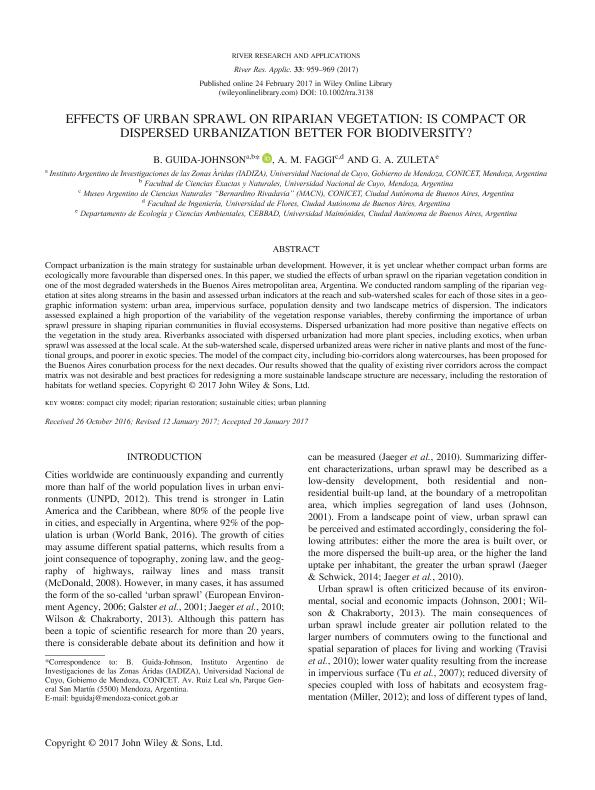Mostrar el registro sencillo del ítem
dc.contributor.author
Guida Johnson, Bárbara

dc.contributor.author
Faggi, Ana Maria

dc.contributor.author
Zuleta, Gustavo Adolfo

dc.date.available
2018-11-20T20:41:19Z
dc.date.issued
2017-07-24
dc.identifier.citation
Guida Johnson, Bárbara; Faggi, Ana Maria; Zuleta, Gustavo Adolfo; Effects of Urban Sprawl on Riparian Vegetation: Is Compact or Dispersed Urbanization Better for Biodiversity?; John Wiley & Sons Ltd; River Research And Applications; 33; 6; 24-7-2017; 959-969
dc.identifier.issn
1535-1459
dc.identifier.uri
http://hdl.handle.net/11336/64800
dc.description.abstract
Compact urbanization is the main strategy for sustainable urban development. However, it is yet unclear whether compact urban forms are ecologically more favourable than dispersed ones. In this paper, we studied the effects of urban sprawl on the riparian vegetation condition in one of the most degraded watersheds in the Buenos Aires metropolitan area, Argentina. We conducted random sampling of the riparian vegetation at sites along streams in the basin and assessed urban indicators at the reach and sub-watershed scales for each of those sites in a geographic information system: urban area, impervious surface, population density and two landscape metrics of dispersion. The indicators assessed explained a high proportion of the variability of the vegetation response variables, thereby confirming the importance of urban sprawl pressure in shaping riparian communities in fluvial ecosystems. Dispersed urbanization had more positive than negative effects on the vegetation in the study area. Riverbanks associated with dispersed urbanization had more plant species, including exotics, when urban sprawl was assessed at the local scale. At the sub-watershed scale, dispersed urbanized areas were richer in native plants and most of the functional groups, and poorer in exotic species. The model of the compact city, including bio-corridors along watercourses, has been proposed for the Buenos Aires conurbation process for the next decades. Our results showed that the quality of existing river corridors across the compact matrix was not desirable and best practices for redesigning a more sustainable landscape structure are necessary, including the restoration of habitats for wetland species.
dc.format
application/pdf
dc.language.iso
eng
dc.publisher
John Wiley & Sons Ltd

dc.rights
info:eu-repo/semantics/openAccess
dc.rights.uri
https://creativecommons.org/licenses/by-nc-sa/2.5/ar/
dc.subject
Compact City Model
dc.subject
Riparian Restoration
dc.subject
Sustainable Cities
dc.subject
Urban Planning
dc.subject.classification
Meteorología y Ciencias Atmosféricas

dc.subject.classification
Ciencias de la Tierra y relacionadas con el Medio Ambiente

dc.subject.classification
CIENCIAS NATURALES Y EXACTAS

dc.subject.classification
Otras Ciencias Biológicas

dc.subject.classification
Ciencias Biológicas

dc.subject.classification
CIENCIAS NATURALES Y EXACTAS

dc.title
Effects of Urban Sprawl on Riparian Vegetation: Is Compact or Dispersed Urbanization Better for Biodiversity?
dc.type
info:eu-repo/semantics/article
dc.type
info:ar-repo/semantics/artículo
dc.type
info:eu-repo/semantics/publishedVersion
dc.date.updated
2018-10-23T14:47:39Z
dc.journal.volume
33
dc.journal.number
6
dc.journal.pagination
959-969
dc.journal.pais
Reino Unido

dc.journal.ciudad
Londres
dc.description.fil
Fil: Guida Johnson, Bárbara. Consejo Nacional de Investigaciones Científicas y Técnicas. Centro Científico Tecnológico Conicet - Mendoza. Instituto Argentino de Investigaciones de las Zonas Áridas. Provincia de Mendoza. Instituto Argentino de Investigaciones de las Zonas Áridas. Universidad Nacional de Cuyo. Instituto Argentino de Investigaciones de las Zonas Áridas; Argentina
dc.description.fil
Fil: Faggi, Ana Maria. Consejo Nacional de Investigaciones Científicas y Técnicas. Oficina de Coordinación Administrativa Parque Centenario. Museo Argentino de Ciencias Naturales “Bernardino Rivadavia”; Argentina. Universidad de Flores; Argentina
dc.description.fil
Fil: Zuleta, Gustavo Adolfo. Universidad Maimónides. Área de Investigaciones Biomédicas y Biotecnológicas. Centro de Estudios Biomédicos, Biotecnológicos, Ambientales y de Diagnóstico; Argentina. Consejo Nacional de Investigaciones Científicas y Técnicas; Argentina
dc.journal.title
River Research And Applications

dc.relation.alternativeid
info:eu-repo/semantics/altIdentifier/url/https://onlinelibrary.wiley.com/doi/abs/10.1002/rra.3138
dc.relation.alternativeid
info:eu-repo/semantics/altIdentifier/doi/http://dx.doi.org/10.1002/rra.3138
Archivos asociados
